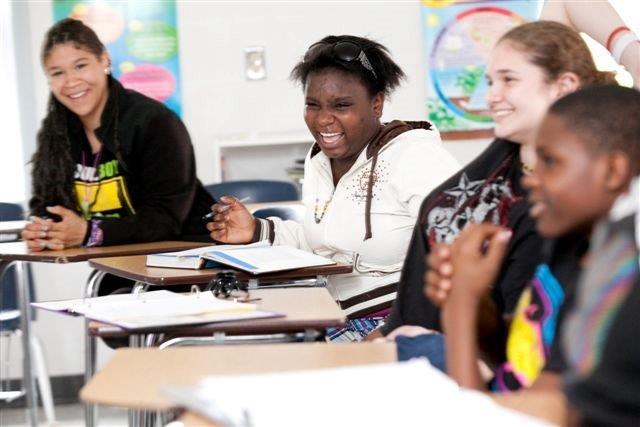
How do you define success? For individuals with intellectual disabilities, establishing goals and measuring success is complex. It requires a thoughtful balance; one that is part science, but also a bit of art. And it certainly isn’t one-size-fits-all.
The recent Endrew vs. Douglas County case took this very issue from theoretical to practical with the strike of a gavel. In this case, the U.S. Supreme Court ruled that to simply provide special education to students with disabilities is not enough; it must be meaningful education. This is what students are entitled to under the Individuals with Disabilities Education Act (IDEA) - the law governing how states and public agencies provide early intervention, special education, and related services. Most importantly, it is what is necessary for education to be effective, let alone successful.
The Endrew decision is a reminder for those of us working with children in behavioral health and education to look at how we define success - and to consider doing so quite differently. Over the past 10+ years, my organization, Grafton Integrated Health Network — which serves children and adolescents with complex behavioral health challenges — has learned critical lessons about measuring success that may be of value to others as the industry continues to evolve.
Move beyond technically sound health metrics. As the Endrew case rightly determined, we must move beyond the basic behavioral health quality standards, and, instead, determine what and how much a student can achieve on a highly individualized basis. Certainly, we must consider overall quality of life standards, such as level of independence, vocational participation, and opportunity to demonstrate voice and choice. But we must also take into account the student’s unique strengths and needs. The wishes of the student and the family must be made a focus, and considered in the context of the resources in the community available to support them.
Ensure that clients are key contributors to the goal setting process. It is absolutely crucial for an individual to be actively involved in setting the goals for his or her own education or care plan. Therapists, teachers and parents must engage students in this process, even recording goals in the child’s own language. In so doing, a child won’t simply be parroting back what an adult is saying. He or she will truly understand, agree to and internalize goals, generating a sense of ownership, confidence and pride in accomplishment.
Measure beyond task achievement. Success should be measured not only by whether or not an individual is capable of completing a particular task, but by the behavior exhibited while that task was undertaken. Was the individual able to exhibit patience? Did he or she collaborate well with others? These are just as important measures of progress.
In fact, leaders from a variety of industries now indicate that soft skills are equally important to technical skills.[1] However, it is only in recent years that researchers and publishers have started to capture these soft skills in an assessment format that can contribute to success.[2]
Goals should be ambitious, but “appropriately” ambitious. In the Endrew case, Chief Justice Roberts argued that IDEA is far more nuanced then simple grade level advancement. In fact, such advancement may not be a reasonable prospect for some children. Instead, an educational program should be devised that is appropriately ambitious for a student based on his or her unique abilities and circumstances. “The goals may differ,” he wrote, “but every child should have the chance to meet challenging objectives.”
We must also be flexible enough to reevaluate and adjust plans over time. In many instances, a goal may be appropriate for a particular setting - a group home or residential treatment center in which an individual is currently living, for instance. But can these same goals then be extrapolated across the entire life of a student? How are we preparing this student for adulthood? Do new goals become more appropriate in order to adapt to an individual’s changing environment and needs?
Take, for example, a young student who has a history of becoming verbally or even physically aggressive in the classroom. Setting a short-term goal for that individual to manage anger or frustration without exhibiting these behaviors might be appropriately ambitious. It also provides a stepping-stone for longer-term goals, building a valuable soft skill, which can be further developed in later plans. As this student grows and is seeking employment opportunities, the skills they have developed in this way will allow him or her to be more successful when frustrating situations — a customer filing a complaint, or a supervisor setting an unrealistic timeline — inevitably arise in a workplace setting.
Setting appropriate long-term and short-term goals — whether related to education or to the development of improved daily living skills — creates momentum for success.
Rigorously gather data. In 2004, Grafton embarked on a structured “goal mastery” initiative, establishing a system to identify, monitor, and evaluate client progress. We sought to achieve 80 percent mastery of goals across the entire organization. I am proud to report that we have not only met but consistently exceeded this target since we began the initiative. That is largely because the goals aren’t just words written in a binder and put on a shelf; they are lived and acted upon, and referred back to on a daily basis.
Multidisciplinary team meetings are held at least monthly to support and monitor each client’s education and treatment progress. Specific progress on goals and objectives are discussed and reviewed. If progress is stymied with respect to the development of daily living skills or education, the team quickly designs strategies and interventions to course correct.
Use a trauma informed approach. In a traditional Applied Behavioral Analysis approach, contrived circumstances are often used to force, and then shape, a particular behavior. Variables are manipulated to determine those that may be contributing to behavior perceived as negative — frustration, for example — so that they can then be removed from the equation.
However, children with intellectual disabilities and other challenges will inevitably face frustrating circumstances on a daily basis; such occurrences hardly have to be artificially constructed. Rather than seeking to control the child through manipulation or coercion, the behaviors can be monitored in a more natural setting. In this way, we are not forcing potentially traumatizing circumstances, but are simply present when natural obstacles are faced.
Imagine a child who is deeply frustrated by math and attempts to escape those feelings through avoidance. In a setting where the variables are contrived, this student might face multiple math tasks in rapid succession to gain a data set that can be used to alter the behavioral plan. Put more simply, the child would be forced into feeling frustrated.
Instead, knowing that math is a triggering event for this child, what if supports were employed during class? Certainly, frustration will still arise and the data can still be gathered. Importantly, the scenario becomes a teaching opportunity that will set the student up to better navigate similar challenges in the future.
Rather than viewing the Endrew ruling as a paradigm shift, I see it as an important evolution. It supports an approach that will help us to better serve children with behavioral health challenges. I know this approach works because I have seen it first hand - we have been applying it successfully for over a decade at Grafton.
While we know the research and science behind working with children with behavioral health challenges, there is also an art to understanding and celebrating the individual. It is only by balancing art and science that we can most effectively support a child, helping them live up to his or her potential, maximize their natural talents and achieve meaningful success.
